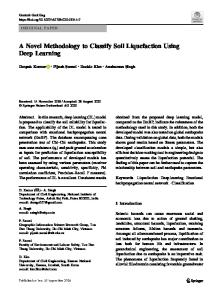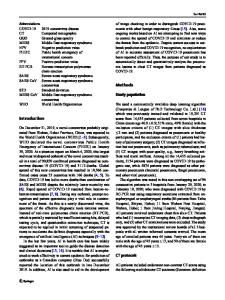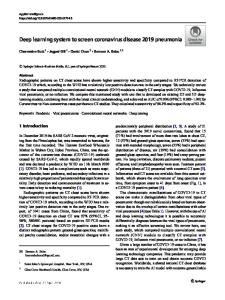Deep Learning Applications to Combat Novel Coronavirus (COVID-19) Pandemic
- PDF / 608,461 Bytes
- 7 Pages / 595.276 x 790.866 pts Page_size
- 8 Downloads / 338 Views
REVIEW ARTICLE
Deep Learning Applications to Combat Novel Coronavirus (COVID‑19) Pandemic Amanullah Asraf1 · Md. Zabirul Islam1 · Md. Rezwanul Haque1 · Md. Milon Islam1 Received: 18 October 2020 / Accepted: 22 October 2020 / Published online: 3 November 2020 © Springer Nature Singapore Pte Ltd 2020
Abstract During this global pandemic, researchers around the world are trying to find out innovative technology for a smart healthcare system to combat coronavirus. The evidence of deep learning applications on the past epidemic inspires the experts by giving a new direction to control this outbreak. The aim of this paper is to discuss the contributions of deep learning at several scales including medical imaging, disease tracing, analysis of protein structure, drug discovery, and virus severity and infectivity to control the ongoing outbreak. A progressive search of the database related to the applications of deep learning was executed on COVID-19. Further, a comprehensive review is done using selective information by assessing the different perspectives of deep learning. This paper attempts to explore and discuss the overall applications of deep learning on multiple dimensions to control novel coronavirus (COVID-19). Though various studies are conducted using deep learning algorithms, there are still some constraints and challenges while applying for real-world problems. The ongoing progress in deep learning contributes to handle coronavirus infection and plays an effective role to develop appropriate solutions. It is expected that this paper would be a great help for the researchers who would like to contribute to the development of remedies for this current pandemic in this area. Keywords Novel coronavirus · COVID-19 · Pandemic · Deep learning · Diagnosis
Introduction The novel coronavirus was first detected in December 2019 and spread around the globe rapidly. Now, it has affected almost every country with forty million confirmed cases and more than a million deaths on 18th October 2020 [1]. It has This article is part of the topical collection “Advances in Computational Approaches for Artificial Intelligence, Image Processing, IoT and Cloud Applications” guest edited by Bhanu Prakash K. N. and M. Shivakumar. * Md. Milon Islam [email protected] Amanullah Asraf [email protected] Md. Zabirul Islam [email protected] Md. Rezwanul Haque [email protected] 1
Department of Computer Science and Engineering, Khulna University of Engineering & Technology, Khulna 9203, Bangladesh
created a tremendous impact on healthcare facilities as well as an economic crisis. To prevent the spread of COVID-19, several national governments have introduced ‘lockdown’ to measure ‘social distancing’ and ‘isolation’ guidelines that limit the movement of people [2]. The coronavirus symptoms can range from cold to fever, as well as acute respiratory illness [3]. The infection of coronavirus is transmitted predominantly via droplets [4]. From the time of civilization, several diseases like heart disease [5], diabe
Data Loading...











